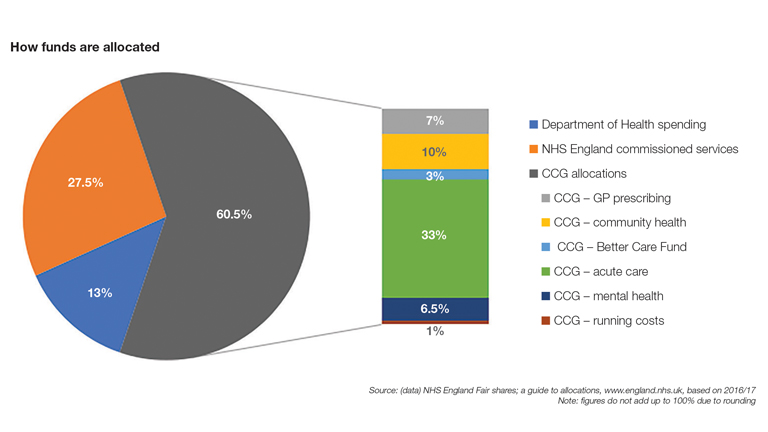NHS in numbers: allocations
The NHS rightly prides itself on its goal of providing equal access to healthcare based on need. While this is a laudable principle, it is not straightforward to put into practice. However, the first step is to divide its overall budget fairly, so that local health economies can put in place local services to meet the needs of their specific local populations.
All four UK nations do this by using a weighted capitation-based resource allocation formula to set budgets for health boards (Scotland and Wales), local commissioning groups (Northern Ireland, where budgets also cover social care) and clinical commissioning groups (England). The principles are similar, with each area set a target allocation that represents its fair share of resources.
In England, the starting point is the GP registered population. This is then adjusted for age, additional need (taking account of health status, morbidity and deprivation) and for unavoidable differences in the cost of providing services due to geographical location (using a market forces factor, MFF).
Weighted populations are calculated for different activities (covering hospital and community services and prescribing) and combined based on the share of each component in national spending, creating an overall weighted population for each commissioner. Each CCG then receives the same amount per weighted head of population.
CCGs are moved slowly towards this target allocation informed by a pace of change policy. By giving more growth to CCGs that are furthest away from target, the aim is – over time – to bring all groups to their fair share of resources.
In England, about 90% of Department of Health and Social Care funding is channelled through NHS England, with just over 60% of this overall funding going into CCG allocations. In 2017/18, core CCG allocations (covering hospital and community health services and prescribing spend) amounted to £74.2bn. NHS England also identified place-based budgets for each area. These included the budgets for specialised services and general practice relating to each CCG’s population, but funded by NHS England.
Allocations were set ahead of 2016/17, providing three fixed years of funding and two indicative. Revised CCG allocations and targets were published for the current year to reflect the addition of £600m to local commissioning budgets as a result of last November’s Budget boost for health.
After a concerted effort since 2016, no CCG is more than 5% below its target allocation. There are just 16 CCGs with allocations more than 5% above target. Within these there are four that are over target by more than 10%, including one West London CCG that started the year 30% over target. Reducing an over-target position is necessarily a slow process as significant cuts in funding are likely to destabilise local services. And over-target CCGs maintain that local pressures are not always recognised by the formula.
New allocations covering five years from 2019/20 are due to be announced in mid-December following the operational planning guidance and alongside near final tariff prices and control totals for next year. With a revised MFF planned for use in the proposed national tariff for 2019/20, allocations will also be influenced by the updated data and tweaked calculation method.
The impact of the new MFF on tariff prices is being phased in across four years. But it is not clear if a parallel transition will be used for CCG allocations as CCGs are already on a transition towards being at target. Any decisions around this are likely to be part of wider discussions on the continued pace of change.
Related content
The Institute’s annual costing conference provides the NHS with the latest developments and guidance in NHS costing.
The value masterclass shares examples of organisations and systems that have pursued a value-driven approach and the results they have achieved.